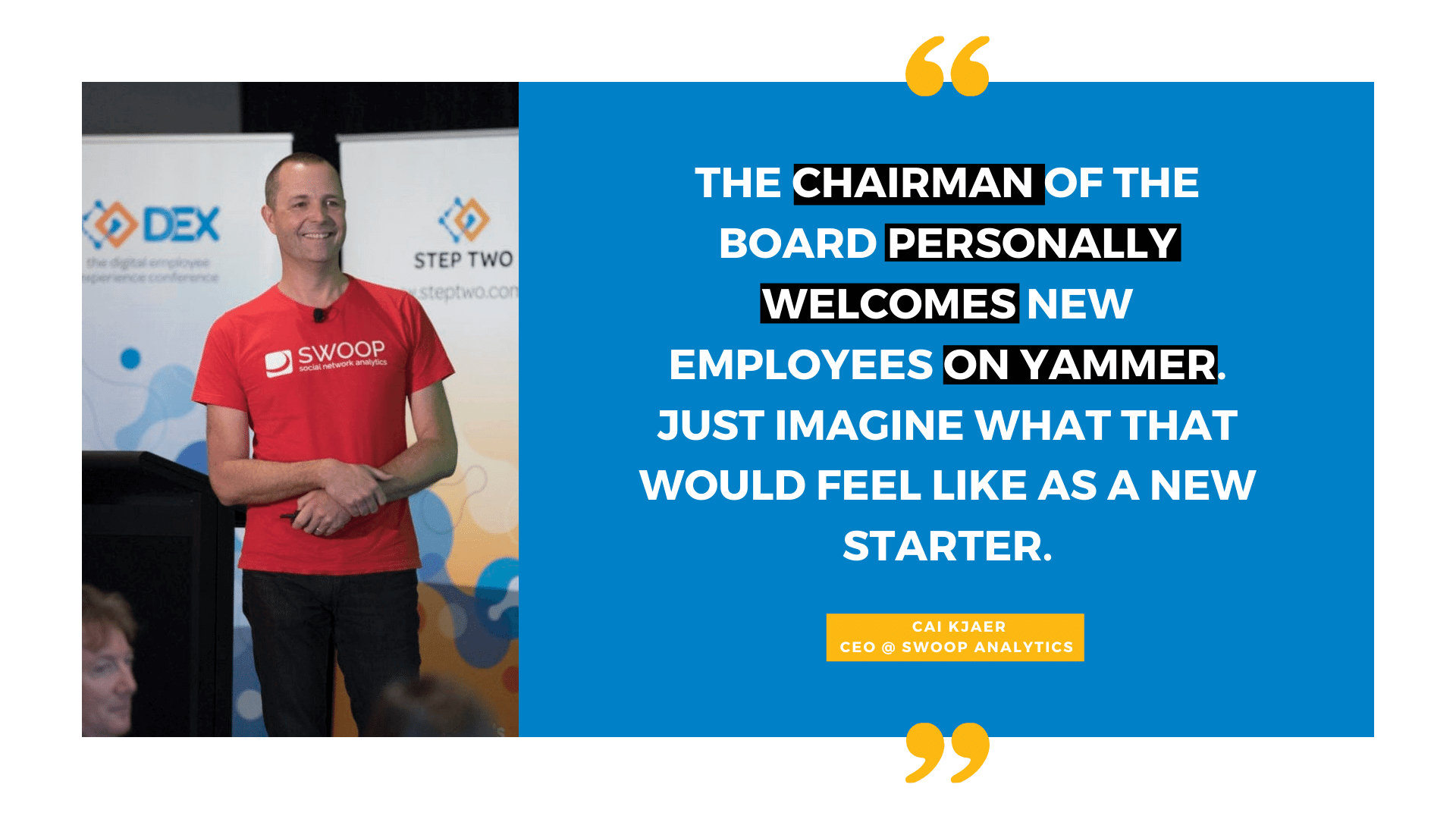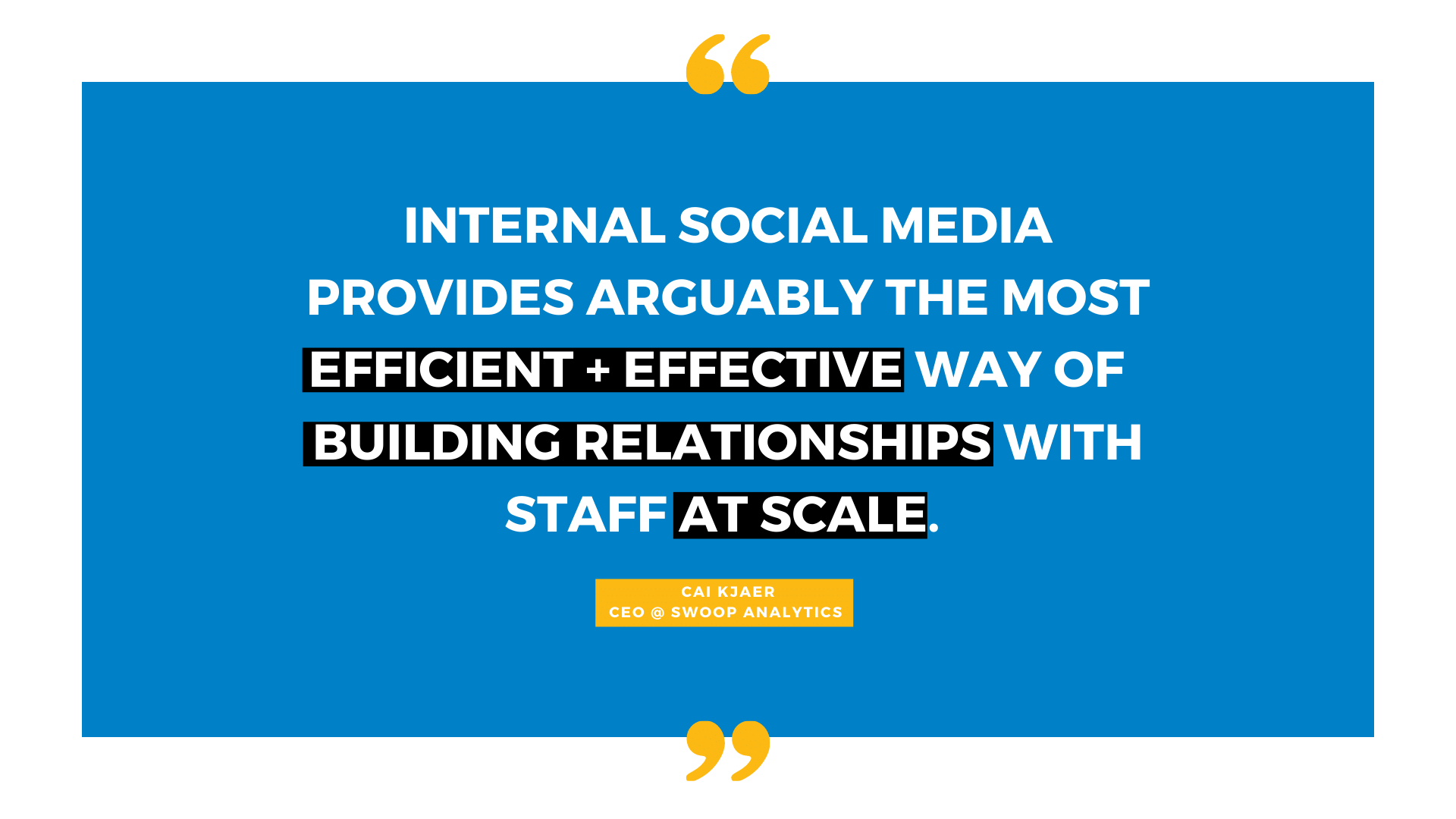I’ve been fortunate enough to learn a lot about the deep value of internal collaboration and communication from the humble, wise and always-energised Cai Kjaer. Cai is one of three co-founders – and CEO – of SWOOP Analytics, and someone I regard as an industry leader on internal or enterprise social networks (ESN) for public and private sector leaders globally.
We’ve been talking recently about how industry leaders’ internal and external social media efforts must align to reduce risk and drive performance. In a COVID world when leaders are desperately seeking understanding of, cut-through and engagement with staff, Cai’s views are particularly pertinent. So I’m thankful Cai took the time to share that wisdom as part of our Digital Leaders series to help others answer the important ‘where to next?’ question for social media right now.
You can follow or connect with Cai on LinkedIn.

Roger @ Propel (RC): Cai – you and I almost sit on the opposite side of the same social media coin – you’re more internal and I’m more external facing. With that framing, I’m keen to hear why you think leaders need to be on social media today. What’s their opportunity?
Cai @ SWOOP (CK): Internal and external social media provide an opportunity to engage people in ways that are in stark contrast to ‘old media’. Today it’s about building relationships with employees internally, or externally with other stakeholders. Social media provides the platform to do this at scale, from anywhere and anytime.
RC: That’s a really simple but key point about building relationships. There’s no doubt most people default to ‘broadcast messaging’ when they think about social media, but relationships are critical. In fact, I’d argue your network is the most valuable digital asset you own. In your experience, what helps cut through this misperception – what’s the ‘lightbulb moment’ for leaders?
CK: I mostly talk with leaders about how they communicate internally, but I think this point applies to the external social media too: Think of this as having a normal conversation. There’s a nice balance between talking, listening and responding.
To emulate this when we are on social media it means that you need to post, read, reply to others, and hit the ‘like’ button. We have come up with a simple rule to help you remember this. We call it the 1-2-3 rule and it draws on the old saying “You have one mouth and two ears”. It goes like this:
Every time you make 1 post, then make 2 replies and 3 likes.
RC: I like that – simple rules are the easiest to follow. And I love that idea of just having a ‘normal’ conversation. Social media is simply a new way of having the same conversations and building the same relationships in my view. So why do you think it is that even the most successful leaders and senior businesspeople still quiver at the thought of social media? What’s scaring or stopping them?
CK: I’ll take myself as an example. I really do want to build my own and our company’s brand on LinkedIn. But then I have these moments of “Oh – what do I write?”, and “Do I have anything interesting to say?”. I think this is a pretty common feeling for most people, actually.
There’s another problem linked to this. There’s a tendency to think about social media mostly from a ‘what can I post?’ perspective. But as my industry colleague Carrie Marshall says about these platforms: “They are not a megaphone. They are hearing aids!”
We need to stop thinking of social media as a way to publish information, and start thinking about how we can listen, then engage and, as a result, build our network. That’s actually incredibly liberating, and I remind myself about it so I don’t have to experience the “writer’s block” moment.
Having said that, the top point I always hear is “I don’t have time”. But that’s an illusion.
The reality is we always make time for what is important.
I simply think most leaders haven’t seen the impact social media can have. Once you see how you can motivate, energise and mobilise your people – at scale – towards what you are trying to achieve via your own social media efforts, the issue of ‘time’ goes away.
—
RC: You talk about staff engagement and even empowerment. What are some of the most common ways you see leaders get value from their social media efforts?
CK: I’m probably quite biased here as our work in SWOOP is focused on internal social media. But, in that sense, for any leader right now the focus is very much on communication strategy and employee engagement. The pandemic and the shift to work from home – and back to ‘hybrid’, depending on where in the world you are – has made this one of the top priorities for many organisations.
It is critical for people to have trust in their leaders during these very uncertain times. Telstra is brilliant at this by the way. The way they have used Yammer to engage staff during the pandemic is worth highlighting. They’ve always been active on Yammer, so it was such a natural thing to do. Same with Westpac too. Westpac executives in New Zealand really benefitted from Yammer during other crises like the recent mosque shooting and earthquakes.
Internal social media provides arguably the most efficient and effective way of communicating and building relationships with staff at scale. Your words, your voice, your authenticity goes straight and unfiltered to your people. All of them. And you get to hear from them directly so you can take action if required.

RC: So, you’re selling me on the benefits of social media, Cai – externally and internally. But to go back to your earlier point, I’m sure some people are reading this wondering where they’ll find the time?
CK: It doesn’t have to take a lot of time, but you need to do it regularly. So, it’s a bit like brushing your teeth. If you think about that 1-2-3 rule I mentioned, we see many leaders who are able to make 1 post, 2 replies and 3 likes in a week. Liking is easy to do, but of course requires that you follow the conversations.
And despite what people think, this can be done spending no more than five minutes per day. I’m not joking. And for those bigger, more strategic communications pieces, or for those in very large organisations, I know the internal communications team often help the CEO by flagging conversations where it could be valuable to get their perspective or reaction.
RC: I 100% agree with you on consistency. We’re all creatures of habit, and love to rely on regularity and routine – particularly with the world as dynamic as it is. Staff want to know you’re there, listening and engaging.
The LinkedIn algorithm loves consistency.
I have three young kids and I talk about the algorithm being a bit like a small child – are you going to get the best out of them if you’re never around or only once every month or so?! But with this regularity, what sort of benefits have you – or perhaps the leaders themselves – seen when they do commit, even just for those five minutes a day as you say?
CK: As organisations grow it becomes harder and harder for leaders to stay connected to the ‘action’. We hear them wanting to know what’s on people’s minds, and social media – both externally and internally – does that for them. Therefore the ‘listening’ part of social media is a big, and often missed, benefit.
From an internal perspective, we also know that employees love hearing from their leaders. But several factors have made this more difficult. Most recently the pandemic of course sent us all home, but even before that many leaders didn’t have their people in the same location. Staff read external media too, so both internal and external social media provides leaders with the ability to engage with their people at scale.
—
RC: What examples come to mind when you think about those doing this really well, Cai – what are they doing differently?
CK: One of our customers is Wiley, the global publishing firm, and we spoke with them about how they use Yammer internally to enable their people to communicate with each other and with leaders. The chairman of the board personally welcomes new employees on Yammer. Just imagine what that would feel like as a new starter.
RC: Powerful. I’ve heard a similar story about Shayne Elliott at ANZ and how he proactively connects with staff on LinkedIn – it’s such a simple act but sends such a strong message to your people, as you say. So, with the examples and lessons you’ve learned over the years, Cai, where should leaders start on social media?
CK: Start reading what people care about. Follow your organisation on external social media and also start to follow the conversations on your internal social network. Then start to engage across both by liking things, or commenting where you have a perspective to share. You can even just say ‘Thank you’ where relevant. By now you’ve probably built the awareness and confidence you need to start posting too, but always remember the 1-2-3 rule to keep the balance.